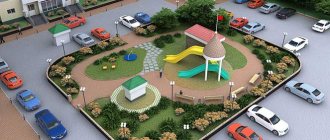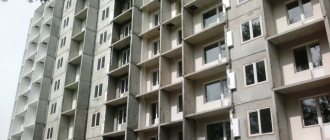Requirements for sites for garbage containers
The implementation of the garbage reform caused changes in the requirements for the circulation of MSW. On December 5, 2021, new SanPiN 2.1.7.3550-19 “Sanitary and epidemiological requirements for the maintenance of municipal territories” were approved for a period of 1 year, until 01/01/2021.
The Rules set out the general conditions that determine: the frequency of waste removal, requirements for containers, the distance of sites from objects, and the procedure for sanitary maintenance. It is worth noting that the Rules do not establish all the requirements for MSW accumulation sites. Therefore, the final decision on its structure and appearance is made by the owner.
Resolution of the Government of the Russian Federation dated August 31, 2018 No. 1039 approved the “Rules for the arrangement of places (sites) for the accumulation of solid municipal waste and maintaining their register.” However, these Rules determine only the procedure for creating MSW accumulation sites and maintaining a register.
Regarding the arrangement itself, they refer to the legislation of the Russian Federation in the field of sanitary and epidemiological welfare of the population and the rules for the improvement of municipalities.
Standards for placing waste collection sites
According to the requirements, containers for collecting solid waste must be placed no closer than 20 meters from residential buildings, childcare centers, schools, sports grounds and recreational areas for citizens, and 25 meters from medical institutions. The distance should not exceed 100 m.
The site must have convenient access roads for garbage trucks, and its location is indicated on the diagram when designing buildings. The placement is coordinated with the authorized local government body, and if it is impossible to fulfill the requirements, the decision is made by the chief sanitary doctor of the constituent entity of the Russian Federation. The Sanitary Rules, in this part, contradict the Rules approved by the Government of the Russian Federation.
Container area for waste dimensions and standards
The size of the sites is selected taking into account the number of containers. Bulk waste collection sites (BWW) are also taken into account. There must be a place to install a stationary fence and the ability for a worker to pass between the containers and the fence for sanitary cleaning.
The surface of the site must be made of waterproof materials: concrete, asphalt, polymers or ceramic tiles.
It is recommended to leave space for a reserve container. Taking into account the organization of separate waste collection, it is recommended to leave space for a reserve container and provide for the possibility of expansion to install containers for plastic, glass, and paper. In total, the number of waste bins should be no more than 10 on one site.
The dimensions of waste sites for SNT are regulated by SNiP 30-02-97* “Planning and development of territories of gardening (dacha) associations of citizens, buildings and structures.” They should be determined at the rate of 0.1 m2 per 1 garden plot. The same standards can be applied to rural settlements.
Fencing
The rules provide for fencing MSW collection sites on three sides with a height of at least 1 meter. Previously it was proposed to use green spaces for fencing. The purpose of the fence is to reduce the amount of garbage carried throughout the surrounding area by wind and animals.
The simplest design is a fence on three sides with a height of 1.5 to 2 meters. This allows you to remove waste without rolling out the container to the garbage truck. However, this solution does not prevent access for animals, provides little protection from wind and does not protect from precipitation.
Some designs include canopies. But not all garbage trucks are equipped with a retractable grab that can remove the container, which complicates trash removal.
Many allocate a separate worker who moves with the garbage truck and rolls out and returns containers to the site, and at the same time sanitizes the site from debris. In addition, this solution allows the use of a fence on the fourth side, which opens when unloading containers. It does not prevent residents from placing waste, but does not allow animals to approach.
The new Rules provide for limiting the container site with a curb, which should protrude by 5-7 cm to prevent spontaneous rolling of tanks on wheels.
Sanitation, cleaning, disinfection
Container sites for waste collection are removed and cleaned immediately after loading MSW into a garbage truck.
The rules require disinfestation (extermination of insects) and deratization (control of rodents) of container sites. However, the frequency of these procedures is not regulated. Disinfection (disinfection of viruses and microbes) of sites is not provided due to possible soil contamination with toxic chemicals.
In practice, service organizations set terms similar to the requirements for the maintenance of containers: once every 10 days, during the dry period, washing the site with water.
It is prohibited to wash the containers themselves on the site. To do this, they are exported to a special facility. site, or use mobile installations for washing and disinfecting containers. In the warm season, the sites are treated with steam.
Where it is not allowed to install container sites
Platforms are not installed in front of the facades of buildings, in front of the entrance to the building and in places of heavy traffic along the internal courtyard passage. If possible, you should not install them in front of the windows of a residential ground floor.
It is not recommended to build sites on avenues and central streets. If necessary, platforms are installed in adjacent streets and driveways. All these factors significantly influence the creation of comfortable conditions for citizens.
If it is impossible to maintain the distance from buildings to waste container sites in accordance with the requirements of the Rules, the chief sanitary doctor of a constituent entity of the Russian Federation makes a decision to change the distance, but not by more than 25%.
Collection and destruction
Removal and processing of bulky waste from storage areas is carried out weekly by specialized organizations, because these operations must comply with sanitary and technical standards. Owners of companies and premises that regularly produce large volumes of bulky waste independently enter into agreements for removal with organizations that resolve this issue. Management companies, homeowners' associations, can deal with such problems only by prior agreement with the owners. Removal and processing of KGM from storage sites is not part of their responsibilities.
It is impossible to get rid of KGM in the usual way, otherwise violators will have to pay an administrative fine in the amount of 2 thousand to 100,000 rubles. (depending on who committed the violation). Garbage containers are located in the designated area.
Changing requirements for container sites during the waste reform
During the waste reform, it was decided to change the outdated Rules for waste sites, developed back in 1988. However, the proposed project turned out to be just a tweaked copy. This explains the annual validity period of the new Rules. However, they have been supplemented by the following requirements:
- no closer than 25 meters to the territory of medical institutions;
- changes in maximum distances were limited to 25%;
- increased the number of containers to 10;
- fencing the site on three sides with a height of at least 1 meter;
- separate accumulation is mentioned;
- cleaning, disinfestation and deratization of sites;
- Instead of the expression “MSW site”, “MSW site” is used.
The line on the use of standard metal containers was excluded from the old norms, thereby allowing plastic tanks of various shapes into circulation.
Metal containers
The production and selection of materials for steel containers is regulated by special GOST 12917-78 “Garbage bins and metal containers for household waste and food waste. General technical conditions". Rolled or edged sheet steel is suitable for the manufacture of tanks. At the last stage, in order to protect from the atmosphere, the containers are coated with a layer of zinc. As a result, the service life of metal containers increases and reaches 20 years.
What trash containers can you use?
The container park has a wide variety. The difference may be in volume, material, lid design, or method of unloading into a garbage truck. In addition to containers, various bins with a volume of up to 3.5 cubic meters can be used to collect household waste.
Basic requirements for garbage cans
Requirements for containers for collecting MSW are contained in the Rules. Garbage containers must have a lid, prevent waste from falling out, and be in good working order. However, residents are reluctant to use the lids due to a sense of disgust. It is unpleasant to grasp the dirty container handle with your bare hand. To solve this problem, manufacturers use various lid drive devices - side levers, foot pedals - but such mechanisms quickly fail.
In addition, containers must have standard devices or reinforced places for gripping by a manipulator when loading into a garbage truck. When unloading, the container lid should open automatically and not interfere with the movement of waste into the car’s hopper.
Unfortunately, there is still no ideal design for the manipulator-container pair. Manufacturers are working in this direction, developing their own equipment options. For this reason, there is no uniform standard for waste storage tanks.
When ordering containers to service your facilities, you need to take into account the design features of the garbage truck manipulator that will remove waste from the site. For this reason, many garbage collection companies offer their own containers.
Container color
Currently, there are no strict requirements for what color containers should be at waste sites. Traditionally, dark tones of green, blue, brown, and red are used. It is desirable that the color disguises dirt, traces of corrosion and harmonizes with the environment.
It is expected that with the introduction of separate waste collection by morphological types: plastic, glass, paper, metal, other waste, each container for a specific purpose will be assigned a standard color. Relevant recommendations are currently being developed. Some territories already use similar color schemes.
Classification of containers by size
- Almost all types of containers have two standard sizes: 20 feet and 40 feet. For large shipments, container sizes of 45 feet in length are in demand.
- It should be noted that 20 feet is a little more than six meters in length, and 40 feet is about 12 meters in length.
There are four main types of containers based on width and height:
- Standard (2.44*2.6m),
- High Cube (2.9*2.9m),
- Pallet Wide (2.5*2.6m),
- High Cube Pallet Wide (2.5*2.9m).
A standard Dry Container is a rectangular metal box with doors on one side. When using such a shipping box, the following symbols are relevant:
- 20 DC – standard 20 feet; 6060*2438*2590mm (external); 5900*2350*2390mm (inside); 2340*2280mm (door); 33m3 (volume); 2330kg(weight); 21800 kg (maximum load capacity).
- 20 HC – high; 6060*2438*2896mm (external); 5900*2350*2700mm (inside); 2340*2585mm (door); 36m3 (volume); 2330kg(weight); 21800 kg (maximum load capacity).
- 40 DC – standard 40 feet; 12192*2438*2896mm (external); 12030*2350*2390mm (inside); 2340*2280mm (door); 67.5 m3 (volume); 3800kg(weight); 26700 kg (maximum load capacity).
- 40 HC – high 40 feet; 12192*2438*2896mm (external); 12030*2350*2695mm (inside); 2340*2585mm (door); 76m3 (volume); 4000kg(weight); 26500 kg (maximum load capacity).
- 45 HC – increased capacity; 13742*2438*2896mm (external); 13582*2350*2695mm (inside); 2340*2585mm (door); 85.7 m3 (volume); 4100kg(weight); 28300 kg (maximum load capacity).
Refrigerated container (refrigerated container) – a container with thermal insulation and a refrigeration unit. The work is carried out from an external source. When transporting by car, you cannot do without an additional generator.
When using such containers, the following designations are used:
- 40 RC , 40 Ref , 40 RE – high 40 feet; 12192*2438*2896mm (external); 11570*2285*2526mm (inside); 2900*2450mm (door); 76.7 m3 (volume); 4100kg(weight); 28000 kg (maximum load capacity).
- 40 Ref , 40 RE – standard 40 feet; 12192*2438*2590mm (external); 11570*2285*2200mm (inside); 2280*2150mm (door); 58.1m3 (volume); 4500kg(weight); 25600 kg (maximum load capacity).
- 20 Ref , 20 RC , 20 RE – small 20 feet; 6060*2438*2590mm (external); 5450*2285*2260mm (inside); 2260*2250mm (door); 28.3m3 (volume); 3200kg(weight); 20800 kg (maximum load capacity).
- An open top container (Open Top or Hard Top Container) is a container with a removable top, which is most often made of canvas. Relevant for transporting long goods.
There are also designs with a hard roof, but they are required much less frequently. When using such containers, the following designations are used:
- 20 OT (soft top) 20 Hard Top Container , 20 HT (hard top) - standard at 20 feet; 6060*2438*2590mm (external); 5890*2320*2354mm (inside); 2300*2350mm (door); 32.2m3 (volume); 2400kg(weight); 21600 kg (maximum load capacity).
- 40 OT (soft top) , 40 Hard Top Container , 40 HT (hard top) - standard at 40 feet; 12192*2438*2590mm (external); 12020*2350*2354mm (inside); 2340*2350mm (door); 66.5 m3 (volume); 3800kg(weight); 26500 kg (maximum load capacity).
Flat Rack is a container with folding walls, suitable for transporting large-sized goods. When organizing transportation, the following designations are used:
- 20 FR , 20 FC , 20 FB , 20 PL - platform 20 feet long; 6060*2438*2590mm (external); 5650*2350*2230mm (inside); 3000kg(weight); 280000 kg (maximum load capacity);
- 40 FR , 40 FC , 40 FB , 40 PL – 40 foot platform; 12192*2438*2590mm (external); 12080*2430*2100mm (inside); 5000kg(weight); 40000 kg (maximum load capacity).
Tank container (tank container, Tank Container) is a tank in a frame used for transporting liquids.
Container parameters may vary depending on the purpose. Such tanks are equipped with unloading devices, thermal insulation and a heating system. When organizing transportation, 20-foot containers with the following designations are used - 20 foot Tank Container , 20 TC , 20 Tank , 20 TK .
Thermally insulated container (insulated or sealed container) - a container protected from external influences, but without a refrigerator.
When organizing transportation, predominantly 20-foot containers with the following parameters are used: 6058*2438*2591mm (external dimensions); 5740*2218*2230mm (internal parameters); 11(Europallets); 28.39 m3 (volume); 21000kg (maximum load).
Container for bulk cargo (container for bulk cargo, Bulk Container) – container for bulk products.
When organizing supplies, the following types of structures with corresponding designations are most often used:
- 20 DC – standard with parameters 6058*2438*2591mm (external dimensions); 5687*2240*2350mm (internal dimensions); 2286*2240mm(door); 2.62t(weight); 27.86t (maximum load capacity); 32.9 m3 (volume).
- 40 DC – standard with parameters 12192*2438*2591mm (external dimensions); 12039*2350*2372mm (internal dimensions); 2336*2291mm(door); 4t(weight); 26.8t (maximum load capacity); 67.8m3 (volume).
- 40 HC – container with increased height with parameters 12192*2438*2591mm (external dimensions); 12039*2350*2372mm (internal dimensions); 2336*2291mm(door); 4t(weight); 30.4t (maximum load capacity); 67.8m3 (volume).
Ventilated Container - a structure with holes to provide ventilation. Used to transport goods requiring oxygen. The types of boxes with the following designations are most often used in work:
- 20 VC, 20 DC with parameters 6068*2438*2591mm (external dimensions); 5900*2323*2367mm (internal dimensions); 2256*1859mm(door); 2.65t(weight); 21.35t (maximum load capacity); 32.4 m3 (volume).
- 40 HC – container of increased height with parameters 12192*2438*2896mm (external dimensions); 12030*2350*2695mm (internal dimensions); 2340*2585mm (door); 76m3 (volume); 4000kg(weight); 26500 kg (maximum load capacity).
- 40 DC – with parameters 12192*2438*2896mm (external dimensions); 12030*2350*2390mm (internal dimensions); 2340*2280mm (door); 67.5 m3 (volume); 3800kg(weight); 26700 kg (maximum load capacity).
Who is responsible for site development?
Each container site has an owner who is legally responsible for its arrangement, serviceability and sanitary maintenance. He has the right to carry out this work independently or to engage third parties under a contract.
The owner of waste collection sites is the owner (co-owner) of the facility to which it belongs. By agreement, the site can serve several objects.
In an apartment building, the garbage area is part of the common property, the owners of which are considered to be the owners of the premises in the building. Responsibility for maintenance lies with the service organization or the owners under direct management.
The sanitary condition of waste collection areas can be ensured by a waste collection company for a fee. She can also carry out the arrangement and ensure the serviceability of the container park.
Sites located on municipal lands belong to the municipality. For example, in private housing, on city streets, etc. The register of all container sites is maintained by the regional operator assigned to the territory.
The local self-government body maintains a register of municipal waste accumulation sites
When the decision to create a container site for waste collection has been made, the next step is to include information about it in the register of MSW accumulation sites. The register is a municipal database of waste sites located on its territory.
It is maintained on paper and electronically and should be freely available to an unlimited number of people. For this purpose, the database is posted on the municipality website.
The following information is entered into the register of places for accumulation of solid waste for each facility:
1. Site location.
The address, geographic coordinates, and layout of the location on the map of the municipality on a scale of 1:2000 are indicated.
2. Technical characteristics.
Covering materials, total area, number of installed containers/bins for MSW and their volume are recorded.
3. Information about the owner of the place.
For a legal entity, the full name, registration number in the Unified State Register of Legal Entities, and actual address are indicated. If the land for the site belongs to an individual entrepreneur, then the surname, name and patronymic of the owner, registration number in the Unified State Register of Individual Entrepreneurs, and place of residence according to registration are entered in the register. About a private person, his personal and passport data, place of residence and contacts are recorded.
4. Sources of generation of MSW that are stored on site (information about capital construction projects).
Land plot as part of the common property of the MKD
950512










